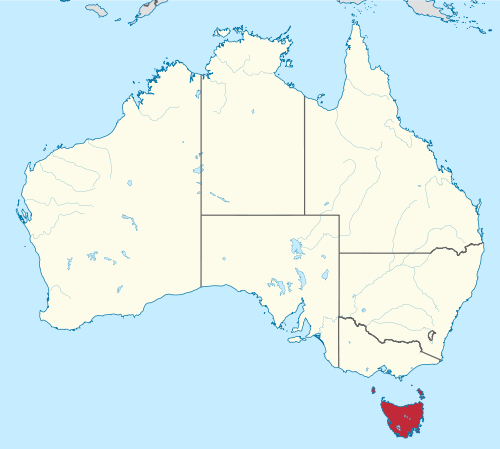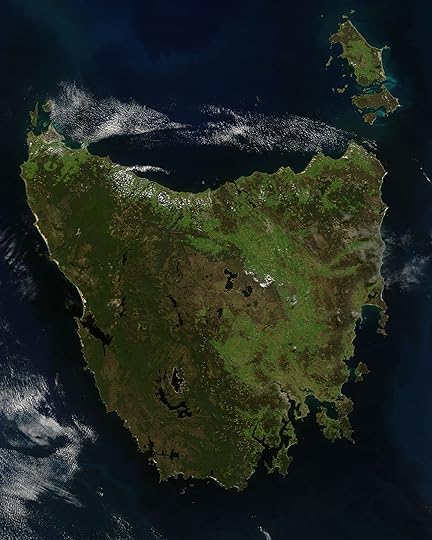The History Book Club discussion
AUSTRALIA/OCEANIA
>
TASMANIA
date newest »
newest »
 newest »
newest »
Slogan or nickname
The Island of Inspiration;
The Apple Isle;
Holiday Isle
Motto(s)
Ubertas et Fidelitas
(Fertility and Faithfulness)
The Island of Inspiration;
The Apple Isle;
Holiday Isle
Motto(s)
Ubertas et Fidelitas
(Fertility and Faithfulness)
Facts:
Coordinates
42°S 147°E
Capital city
Hobart
Demonym
Tasmanian
Tassie (colloquial)
Taswegian (colloquial)
Government
Constitutional monarchy
• Governor Kate Warner
• Premier Will Hodgman (Lib)
Australian state
• Established as Van Diemen's Land 1825
• Responsible govt.
(as Tasmania) 1856
• Became state 1901
• Australia Act 3 March 1986
Area
• Total 68,401 km² (7th)
26,410 sq mi
• Land 67,031 km²
25,881 sq mi
• Water 1,370.42 km² (2%)
529 sq mi
Population
(Mar 2018)[1]
• Population 526,700 (6th)
• Density 7.86/km² (4th)
20.4 /sq mi
Elevation
• Highest point
Mount Ossa
1,617 m (5,305 ft)[2]
Gross state product
(2014–15)
• Product ($m) $28,207[3] (7th)
• Product per capita $44,011 (8th)
Time zone(s)
UTC+10 (AEST)
UTC+11 (AEDT)
Federal representation
• House seats 5/150
• Senate seats 12/76
Abbreviations
• Postal TAS
• ISO 3166-2 AU-TAS
Emblems
• Floral Tasmanian blue gum
(Eucalyptus globulus)[4]
• Animal Tasmanian devil
(Sarcophilus harrisii)[5]
• Bird Yellow wattlebird (unofficial)
(Anthochaera paradoxa)[6]
• Mineral or gemstone Crocoite[7]
(PbCrO4)[8]
• Colours Dark green, red & gold
Website
www.tas.gov.au
Coordinates
42°S 147°E
Capital city
Hobart
Demonym
Tasmanian
Tassie (colloquial)
Taswegian (colloquial)
Government
Constitutional monarchy
• Governor Kate Warner
• Premier Will Hodgman (Lib)
Australian state
• Established as Van Diemen's Land 1825
• Responsible govt.
(as Tasmania) 1856
• Became state 1901
• Australia Act 3 March 1986
Area
• Total 68,401 km² (7th)
26,410 sq mi
• Land 67,031 km²
25,881 sq mi
• Water 1,370.42 km² (2%)
529 sq mi
Population
(Mar 2018)[1]
• Population 526,700 (6th)
• Density 7.86/km² (4th)
20.4 /sq mi
Elevation
• Highest point
Mount Ossa
1,617 m (5,305 ft)[2]
Gross state product
(2014–15)
• Product ($m) $28,207[3] (7th)
• Product per capita $44,011 (8th)
Time zone(s)
UTC+10 (AEST)
UTC+11 (AEDT)
Federal representation
• House seats 5/150
• Senate seats 12/76
Abbreviations
• Postal TAS
• ISO 3166-2 AU-TAS
Emblems
• Floral Tasmanian blue gum
(Eucalyptus globulus)[4]
• Animal Tasmanian devil
(Sarcophilus harrisii)[5]
• Bird Yellow wattlebird (unofficial)
(Anthochaera paradoxa)[6]
• Mineral or gemstone Crocoite[7]
(PbCrO4)[8]
• Colours Dark green, red & gold
Website
www.tas.gov.au






Tasmania (/tæzˈmeɪniə/;abbreviated as TAS and known colloquially as Tassie) is an island state of Australia. It is located 240 km (150 mi) to the south of the Australian mainland, separated by Bass Strait. The state encompasses the main island of Tasmania, the 26th-largest island in the world, and the surrounding 334 islands.
The state has a population of around 526,700[1] as of March 2018. Just over forty percent of the population resides in the Greater Hobart precinct, which forms the metropolitan area of the state capital and largest city, Hobart.
Tasmania's area is 68,401 km2 (26,410 sq mi), of which the main island covers 64,519 km2 (24,911 sq mi).
It is promoted as a natural state, and protected areas of Tasmania cover about 42% of its land area, which includes national parks and World Heritage Sites.
Tasmania was the founding place of the first environmental political party in the world.
The island is believed to have been occupied by indigenous peoples for 30,000 years before British colonisation.
It is thought Aboriginal Tasmanians were separated from the mainland Aboriginal groups about 10,000 years ago when the sea rose to form Bass Strait.
The Aboriginal population is estimated to have been between 3,000 and 7,000 at the time of colonisation, but was almost wiped out within 30 years by a combination of violent guerrilla conflict with settlers known as the "Black War", intertribal conflict, and from the late 1820s, the spread of infectious diseases to which they had no immunity.
The conflict, which peaked between 1825 and 1831, and led to more than three years of martial law, cost the lives of almost 1100 Aboriginals and settlers. The near-destruction of Tasmania's Aboriginal population has been described by some historians[who?] as an act of genocide by the British.
The island was permanently settled by Europeans in 1803 as a penal settlement of the British Empire to prevent claims to the land by the First French Empire during the Napoleonic Wars. The island was initially part of the Colony of New South Wales but became a separate, self-governing colony under the name Van Diemen's Land (named after Anthony van Diemen) in 1825.
Approximately 75,000 convicts were sent to Van Diemen's Land before transportation ceased in 1853. In 1854 the present Constitution of Tasmania was passed, and the following year the colony received permission to change its name to Tasmania. In 1901 it became a state through the process of the Federation of Australia.
Remainder of article: https://en.wikipedia.org/wiki/Tasmania
Source: Wikipedia
Flag:
Tasmanian Coat of Arms: